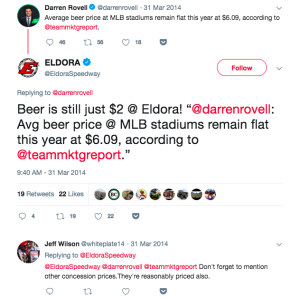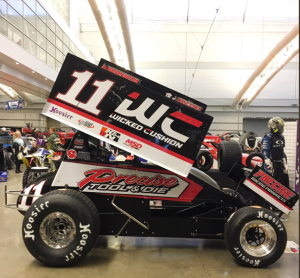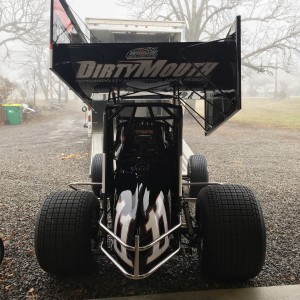Where all the fun happens.
Dropping knowledge left and right. But mostly left.
Tracks: Do you know your Fan Cost Index?
And, are you marketing it?

Great example of marketing the price difference between dirt racing and professional sports!
As a numbers geek through and through, I love looking at costs, return on investment, growth…really any number I can get my hands on. One of my favorite geeky reports to look at each year is the Team Marketing Report’s Fan Cost Index for professional sports.
Why? It points out a critical disparity in the cost difference between most dirt race tracks and professional sports venues.
And guess what that creates? You guessed it: An enormous marketing opportunity for local race tracks, events and series’.
The TMR “Fan Cost Index” represents the cost for a family of four to attend an MLB or NFL game. The TMR staff compiles costs for all venues in that sport using the price of four average weighted non-premium tickets combined with four sodas, four hot dogs, two beers and two souvenir caps, plus a parking spot.
In 2018, the NFL’s average Fan Cost Index increased .7 percent to $536.04 for a family of four. In the MLB, it rose 2.4% to $230.64.
In the NFL, the ticket cost is the bulk of that $536.04. FYI: the average beer price is $8.17, soft drinks are $4.71 and a hot dog is $5.23. They’re squeezing every last dime out of those ticket holders because they’re likely only attending one game per year and willing to splurge on that experience.
In the MLB, the average ticket price is much lower at about one third of what the NFL charges. Beer is also $5.98, soft drinks are $4.65 and a hot dog is $5.01, all on average across the 32 MLB ballparks.
Think about that and compare it to a local race track. Let’s say you’re looking at a ticket price of $14 with kids under 11 free – that’s$28 in ticket costs. Let’s say $12 in 4 hot dogs, $8 in 2 beers, $8 in 4 sodas, $40 in 2 hats and free parking. You’re totaling out in $96 for one splurge-worthy night at the races.
Since race tracks depend on fans coming every single week, let’s talk about the average cost of repeat attendance.
You’re likely not going to buy apparel every night, so let’s say your average night for a family that attends multiple times is $56/family. Not bad, right?
From that math, it’s easy to make the case for how much cheaper it is to attend an entire weekly racing schedule than even one NFL game, as attending a race costs 10% of what an NFL game costs to attend.
Here are some thoughts on this info:
- When you have more games or events, the prices have to be lower to entice customers to attend more than once.
- For repeat attendance, they also have to be wowed by the experience once they get there. (Even better if they’re sharing that experience with others!)
- While we’re on the subject of repeat attendance, they must be invested in the entertainment itself. Whether that’s emotionally or financially. (Think sports aren’t emotional? Insult someone’s favorite NFL team and just wait.)
The first two points are pretty self-explanatory but I could write a short novel on the third.
Don’t worry: if I do, it won’t be today.
But here is something to think about: Yes, the example Fan Cost Index of a local race track might be 10% of what an NFL game costs to attend but those same NFL fans get to watch all of the others game from the comfort of their home FOR FREE the rest of the year. Ponder that.
If you only heard about your local NFL team on social media, on a podcast or on a live broadcast that you had to pay for each year, how interested would you be in the NFL? Would you still be willing to pay $536.04 to attend one game? Would you even pay $96 to watch one game?
There are so many points that can be made out of this thought alone about live streaming, content marketing and, say, back-gate driver tracks that we could be here for days. Also: don’t worry. Not today, friend.
In fact: you’re excused to think about how you can use this information to your advantage in your marketing.
xo.
Kristin
P.S. This doesn’t just apply to tracks, series and event promoters. It’s to the racers’ advantage to bring more fans to the tracks…or even the sport in general…to be able to serve marketing partners or the fans themselves with products or services.
Sponsorship: A mile wide and an inch deep.
It’s the time of year when we see a flurry of press releases in the racing world that boasts exactly how many sponsors a racer has as he or she launches this season’s racing campaign.
While the world is all about big numbers, racing is different. In racing, you win by having the lowest times and finishing in the #1 spot. 
When I think about adding sponsors, I consider that concept. I evaluate what our team, event or property will be trading off to post another ‘number’. And I advise my coaching clients to do the same.
For every marketing partner you add, you potentially split your time, effort and the attention span of your audience. Keep in mind that if you’re not maxed out on any of those assets, then adding another partner is purely a positive for your team.
But I often wonder when I see lists of 20+ sponsors on a release: is that team providing equivalent value to those partners?
Or are they going a mile wide and an inch deep?
If you have two dozen partners, but each of those businesses only invests in one or two properties, how equivalent is the promotion of that partnership going to be? You’re splitting your time between 24 businesses on your race car, social media, website, and activations. But they’re only promoting you.
The racer is getting the majority of the benefit, as their audience will come to equate your team or property with that business, but your audience is struggling to keep track of who your partners are and, most importantly, why.
As an aside, many racers who struggle to find sponsorship are starting the conversation with numbers that equate to a small businesses’ entire marketing budget, if they even have one. Think about what it means for that business to invest their entire budget into you, while you ask 29 other companies for that same investment.
Having fewer partners that you build deep, significant relationships with is my personal preference for approaching sponsorship.
The benefits of investing heavily in fewer partners can mean a number of things for you and your sponsors in addition to the benefit of not splitting your time, energy and efforts across dozens of businesses.
Your partnerships are likely to become long-term. As your brand becomes intertwined with theirs, and the more of an asset you are to their business, the less likely they are to give up that relationship.
When you’re doing your job well, you become a driver of success in their business. As we’ve talked about in the past, that might mean more bottom-line customer sales, but it also might mean higher employee retention rates, deeper vendor relationships, more positive publicity in a specific community or audience, etc.
Most businesses will not cut out a driver of success in their business. In fact, good business minds will invest more heavily in those assets. Which is another benefit for you: fewer partners generally means more value to your team in the long-term.
In the past, we’ve talked about how serving your current sponsors is the absolute best way to attract new ones in my opinion.
Today, I hope you’ll think about why the number of sponsors you have is most likely insignificant compared to the depth of those partnerships.
Instead of a flurry of activity to add a few lower-dollar logos to your car or the signage at your track, consider investing in your current partnerships and seeding the relationships with a few companies that you can bring significant value to now and in the future.
Yes, a new marketing partner will add value to your team in some way, whether that’s financially, with in-kind products, with publicity or a number of other valuable assets. But what will you give to provide value to that sponsor?
xo.
Kristin
Make It Easy for Marketing Partners to Say ‘Yes’
There’s a group of racers that still believe that sponsorship is just a logo and a check. Some tracks still think a billboard does the trick, too. Since you’re taking the time to read this newsletter, you’ve likely already qualified yourself out of those groups. Welcome! 
So, you’re one of the racers who are as motivated to find marketing partners as they are to perform well on the track. You’re ready to match up your offerings – your tangible assets and your audience – to a company’s goals, whether those are customer-focused, business-to-business or internal.
Instead of talking about sponsorship mentality, I wanted to give you some ideas about where you, the motivated and educated sponsorship seeker, might get hung up in the process: making it easy for sponsors to say ‘yes’ to your offer.
Have you ever wanted to buy something and gone to the business with the full intent to make a purchase, only to walk out with nothing in hand? Ask yourself, why?
When you’re buying a gallon of milk or a pack of zip ties, you might not have a hard time purchasing a different brand than your preferred, or choosing a different color. You might pay a little more than usual, or have to make a different size work. But you still make a purchase.
But, let’s say you’re buying a car. Or a computer. Or a couch.
When you’re spending a decent sum of money on a purchase you don’t make often and that has utility in your life, the buying process becomes more complicated.
How do you find the right product? Can you look at it in person? How will you pay for it? Does the company you’re buying from have a good reputation for service?
Of course, it does need to have all, or most, of the bells and whistles on top of providing the function you need it for.
But that’s where I see motivated racers getting caught up in the process. Many of us worry about creating too many options for companies to buy instead of making sure that if they want the package or solution you’re offering, they’re able to buy it easily.
Here are a few tips for how to make it easy for sponsorship buyers to sign on:
Have an online presence. The first thing a marketing manager will do when they see your pitch or decide to reach out to you on their own is Google you. What will they find? Do you have a website and social media channels? Will it what they find be clear, professional and – possibly – be about more than on-the-track performance? Are you active and promoting your current partners?
(Note: Need help building a website? Here’s a link to my guide to building one for under $100!)
Make your offerings clear. It’s great to have flexibility and options, but once you’ve gotten past the Google test and are ready to talk about what you can do for that company, you should already be narrowing down the (customized) list of ways you can serve them. And making it concise. Too many options is overwhelming, and puts the work on the decision maker instead of you.
Treat business as business. A clear, professional way to contact you is important. I can’t tell you how many times in the advertising industry I would try to call or email a potential partner for a company I repped and couldn’t find their phone number, got a voicemail that wasn’t appropriate or was given an email address that was questionably appropriate. That’s the first barrier.
The second barrier is treating payment and execution like a business. Do you have a contract? How will they be making payment? Will they get a professional invoice with payment terms that they can use for their tax purposes? Making a check out to someone they don’t know is a bigger leap than making one out to a (legal) company attached to a (legal) contract with an invoice to prove it.
Having the right sponsorship philosophy is critical to starting down a successful path with marketing partners, and giving them the solutions they need is the only way to get them on board.
Now it’s time to go to the next level and actually close deals with the companies who want to get on board with your team or track.
xo.
Kristin
10 Pieces of Offseason Content for Your Race Team, Track or Business
Right now, most of us are still in the offseason. If you’re one of the blessed few that are actually racing now, know that we wish you the best but can’t truly be happy for you at the moment in the nicest way possible. (Mostly kidding.)
During the season, the business side of a race team or track most often goes into maintenance mode. You’re not taking on new projects. You’re focused on the performance and day-to-day of your car or event. 
The offseason, then, is a critical time for all of the off the track work that most of us can’t get to during the season. For you, that might include: pitching sponsors and securing marketing partners (you know that I can’t help putting that first on the list!), building and doing major maintenance projects, gathering and assessing data, doing taxes and paperwork, and giving your team a much-needed breather.
One of the things that often gets overlooked in the offseason is the ability to build your brand because in our minds there isn’t much going on. If we’re not racing, we’re not promoting.
The fact that we’re not racing, though, means fans are hungry for information and there is generally a lack of it. It’s the perfect time to grab some attention for your team or business, and lay the groundwork for in-season content and opportunities.
(P.S. Our 30 day free Build a Brand Challenge has generated results for countless teams. Sign up here for a month’s worth of ideas on strengthening your brand’s presence.)
So, what do you talk about in the offseason? Here are a few ideas for you:
10 Pieces of Offseason Content for Your Team, Track or Business
- Countdown posts. Tried and true, and maybe a bit tired, these are the easiest way – especially for tracks – to both create content that promotes your upcoming schedule, shares your excitement and most likely involves other profiles that you can tag for maximum share-ability. I don’t recommend a daily countdown because fans tend to tune out, but think about how you can incorporate this into your promotional schedule.
- Building or improvements. Most race teams are pretty good about sharing their shop photos throughout the build process, but I don’t see many tracks, events or businesses showing the behind the scenes of getting ready for race season. They’re not always the sexiest photos, but showing billboards going up, track work, tickets being sorted, picking up trophies…anything you do behind the scenes shows fans the passion and hard work that go into making a racing season when all they see is a closed gate.
- Sneak peaks or teasers. New event coming up on your schedule? Different paint scheme? Make sure you tease it and release it. If you’re a track or event, share news from the teams that support you, too!
- Marketing partner promotions. Guess what? Just because the calendar turned to a new year, it doesn’t mean your partnerships expired. Most partnerships don’t run from January 1 – December 31. If yours didn’t, you can still get lots of mileage for you and for your past season marketing partners by promoting their products, services and involvement with your team. Plus, they’re much more likely to return if they’re still seeing the benefits of an effective marketing strategy. Another bonus? When another potential sponsor sees what a good job you do for your existing partners, they’re much more likely to sign on, too.
- Upcoming schedule. Another obvious one, but I rarely see tracks or racers promote specific events other than the first one on their schedule. Usually, they’ll announce their first race or swing or put out their whole schedule. There is a whole lot of ground that can be covered between those two tactics, and it’s a great time to highlight why you’re so excited about specific events or promotions.
- Apparel and ticket offers. Yep, you can still generate income in the offseason. You can offer last season’s apparel at clearance prices, create early bird or pre-order offers for this season’s merchandise or tickets, or advertise season ticket packages. I highly recommend making these offers available on your website because every step you require a potential customer to take, the less likely they are to purchase. That goes for sponsorship, too. Check out this post on how and why you need to make buying easy.
- Team member highlights. Guess what? It’s probably not just you making your team or event go. The offseason is a great way to make the people who support you feel valued. A quick post on your crew chief, your flagman, the racers who support your track…there are any number of people that your fans might want to get to know.
- You. Yep, you read that right. How many track promoters put their face on social media and tell fans why they’re doing what they’re doing. How many drivers actually talk about what got them into the sport, who influences them and who they are away from the track. Those kind of personal connections are what make people like you. In so many ways, that’s what makes this racing world go round. Shameless plug: I share most of that behind the scenes info on me and my business over on Instagram as @kswartzlander. Come say hi!
- Past season highlights. Proud of what you’ve built? Now is a great time to throw it back to your favorite event or track from the last season, a finish you fought particularly hard for, a fan that you loved connecting with or a marketing promotion that left you with a sense of accomplishment.
- Trivia. Offering a ‘did you know?’ post or asking a trivia question is a really broad, easy way to drive engagement. You can tie it to a giveaway, which is a great way to both grow your following and highlight things that a fan can purchase if they don’t win. Bonus idea: let’s say you’re sponsored by the best iced tea company in Pittsburgh and have mentioned your favorite tea flavor in past press releases. Wouldn’t that be a great way to promote a marketing partner while engaging your fans with their products and your brand?
If you’re searching for ways to promote your team or business in the offseason, the list above will give you a great starting point for creating content that strengthens your brand, engages your audience and lays the groundwork for a successful season. Bonus points if you generate income!
xo.
Kristin
P.S. Need more ideas on how to utilize your off-season? Check out Offseason Got You Down? Beat the Funk. or Off-Season Panic Setting In? How to Get Back on Track. You might also like Searching for sponsors this off-season? Ask yourself these 2 questions.
Dave Blaney Teams with Pete Grove to Launch 2018 All Star Campaign
High Point, N.C. – (January 15, 2018) – ‘The Buckeye Bullet’ Dave Blaney will return to full time sprint car racing in 2018 for the first time since 1997 with the All Star Sprint Circuit of Champions in the Pete Grove-owned No. 70.
Blaney, who earned his most recent victory with the All Star Sprint Circuit of Champions in August of 2017 at the $10,000-to-win Open Wheel Championships at Atomic Speedway, will run the full All Star schedule along with select World of Outlaw shows and major events.

Dave Blaney will partner with Pete Grove in 2018 to run the All Star Sprint Circuit of Champions 2018 Schedule
“I’m really excited to be partnering with Pete and racing more this year,” Blaney said. “It’s a good fit for both of us, in my opinion. We’re going to be taking care of the cars here in North Carolina, and that takes a lot of time off of his plate to focus on his businesses. And he’s got great equipment and the drive to go out and be competitive.”
Blaney and Grove will start their All Star campaign in Florida at Bubba Raceway Park and Volusia Raceway Park in February.
“It’s a short time to get it all ready for Florida but I’m excited enough to get back to a full time schedule that I’m not worried about the amount of work we have in front of us,” Blaney said. “I’ve been focused on working with Ryan over the last few years and that’s only allowed a part time schedule. The more you race, the better you’re going to be so I’m ready to take that on again. And Ryan’s going to be able to be involved in the team a bit, so he’s excited about that.”
Crew member Eric Bergen will be joining the team along with Blaney’s marketing partners Mohawk Northeast and Beltline Body Shop. Grove’s iconic blue No. 70 will continue to be supported by his long-time partners Lumber and Things, Linc Systems, River City Wood Products, Premier Pallet, Lutes Custom Cabinetry, Maria at FK Rod Ends and Winters Performance.
“Throughout the years, I’ve always gotten along well with Dave,” Grove said. “He ran a modified for me at some specials here and there and I always admired him as a racer. I’m really excited to be getting back to full time racing, especially with how we’re running the team. With two companies and 45 employees, it’s hard to take the time we needed for racing and run the businesses, too.”
Catch Dave Blaney and the Pete Grove No. 70 team next at Bubba Raceway Park on February 1-3, 2018 with the All Star Sprint Circuit of Champions.
About Dave Blaney Racing: One of the most respected and successful sprint car racers in the ranks, Dave Blaney won championships with the World of Outlaws Sprint Car Series and the USAC Silver Crown Series, along with marquee events like the Knoxville Nationals, the King’s Royal, the Historical Big One, the Chili Bowl and the Gold Cup, before committing to a full time NASCAR career in 1998. His 2018 All Star Sprint Circuit of Champions campaign will be his first full-time sprint car season since he began his NASCAR career. For more information, please contact Kristin at kristin@
Mid-Season Sponsorship: Where to Focus and Why
For most of us, racing season is about performance in the garage and on the track.
It’s easy once the season gets going to go into ‘maintenance mode’ – where you’re just maintaining and improving your car and showing up to the races on your schedule – and forget about ‘sponsorship mode’.
Once the racing season starts, though, you have a ton of opportunities to both:
- attract new marketing partners, and,
- activate your current sponsor relationships.
Many of the sponsorship-seekers and clients that I speak with are comfortable with the idea of activating their current marketing partners because they know it’s critical to making their sponsors happy now and in the future.
But the underrated part of keeping your current partner(s) happy?
Sponsorship activation often attracts new sponsors, too.
And there is no better or easier time to activate your partnerships than during the season, when fans and the media are paying the most attention to your program and you have lots of opportunities to bring your partnership alive.
When potential marketing partners see how well your promote your current partners, it’s easier for them to see exactly what they could be investing in and what kind of job you’ll do for them in the future.
They see what you create, whether that’s marketing done in person (appearances), at the race track (autograph cards, apparel, announcer information and, you know, being a person and interacting with fans), online (social media) or any other way you put information about your sponsors out there.
They see the response to what you create, whether that’s through the reaction of your fans online or offline or the public interaction with your marketing partners.
They will use that information to gauge whether they’ll be interested in working with you when you approach them or if they want to approach you on their own, which happens often for our team and clients who engage and activate their current partnerships.
Activating your current partnerships isn’t the only way to attract new partners, though.
The same opportunities you have to promote your current partners are what you can use to attract and pitch new sponsors.
For example, racing season is the only time you can truly bring motorsports marketing to life for a potential sponsor who has never been to the race track or hasn’t seen you in action in real life. Hospitality at the track is one way to show a potential partner what they could be a part of.
But getting a marketing manager to take a night away from their family isn’t the only way to show off your skills. Being active on social media while, again, the fans and media are chomping at the bit to be a part of the racing scene is a great way to show potential partners that your fans are engaging with your content. (And they can be a part of that!)
Describing what you can do in a proposal is 100% different that showing potential partners what you actually do during the season.
Don’t sleep on your sponsorship goals because it’s racing season. Now’s the time to take advantage of the opportunity that not many racers think is out there – the chance to attract a new sponsor and delight a current partner.
xo.
Kristin
P.S. Want more on this topic? Check out my related post on how to be sponsor-able!

Connect!